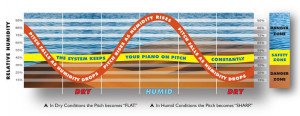There is one factor alone that is responsible for most of the wear and tear on a piano. That factor is humidity. The purpose of this article is to explain in detail how humidity affects a piano, and then to discuss how this problem can be solved with the installation of a humidity control device.
I learned to tune pianos in Hawaii where I saw first hand the way that humidity could take a brand new piano and bring it to it’s knees. In numerous cases, this transformation took only two to five years. Although the humidity in your local area may not be 80% year round like it is over there, it is still causing the same effect, just at a slower rate.
The first effect of humidity is rust. Piano strings are made of steel, although not stainless steel as one would find in the kitchen. That means that they are susceptible to corrosion. The lifespan of a string is directly related to how quickly it rusts. Once a string rusts, it becomes brittle and will easily break when you try to tune it. One break is tolerable. After three or four start breaking, it means the whole set is going bad. Rust also affects the tone. Once the strings get even a thin veneer of rust it loses the bright pure tone it had when it was new.
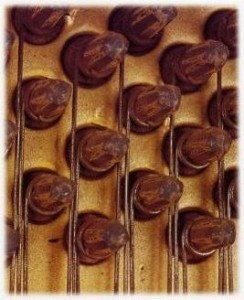
When a piano is stored in a low humidity environment, the strings will last seventy five years before they start breaking. They may even last one hundred years. When exposed to high humidity, strings will last less than half that time. In very high humidity such as Hawaii, strings will become caked with a very thick visible layer of orange rust within two to five years. Anyone living near the ocean is also at risk. Consider that well before the strings start breaking, they will lose their tone, and the instrument becomes less enjoyable to play. Therefore, at all costs, one should try to control the humidity inside their instrument so they can enjoy it for years to come.
The other effect of humidity is that seasonal changes in humidity will cause the piano to go out of tune. This effect is not related to rust per se. Instead is has to do with the humidity alternating between wet and dry cycles. In high humidity the piano expands and stretches causing the piano to go sharp. In low humidity, the piano shrinks and goes flat.
Humidity also has a tremendous affect on the mechanical parts inside a piano. Most moving parts inside a piano use a hinge called a flange. A flange uses no grease or ball bearings. Instead there is a piece of wood with a tiny hole in it. That hole is lined with felt and a pin is inserted into it. The pin is able to turn by rubbing against the felt. When the humidity is high the wood expands and the hole gets tighter causing the pin to stop turning. Each time you press a key, at least three such flanges are engaged. Whenever a key is “sticking”, most of the time it is because one of those flanges is swollen from humidity exposure. This is especially true for intermittent problems. If your piano behaves on way in one type of weather, and another way in another type of weather, the culprit is obvious. I once repaired a Samick piano in Hawaii in which every single damper inside the piano had frozen solid due to humidity exposure. The net effect was that when you played it every note rang indefinitely, even once you let go of the key. It took about six hours to repin every single flange and get it working again.
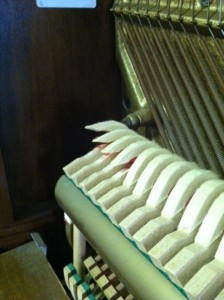
The good news is that there is a solution to this problem. Dampp Chaser Corporation has created a device called the Piano Life Saver System which keeps the humidity inside the instrument at the appropriate level day in and day out. I own one in my piano, and strongly recommend all my clients get one as well, especially those near the ocean. My piano stays in tune, and I have no mechanical problems when the weather changes. Here is an example of how the system works.
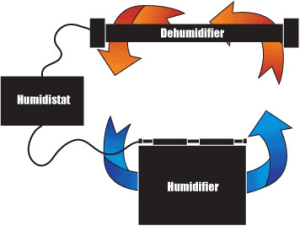
The device has one or more long black heater rods, and a black box called a humidistat which detects if the humidity is too high, then activates the rods. Because it turns them on intermittently, it uses less electricity, and also avoids making the piano too dry which is equally problematic. The entire system takes 1-2 hours to install by a qualified technician, such as myself. The cost is little more than getting your piano tuned, and will save you thousands over the lifetime of the instrument.
Here is a photo of the upright system:
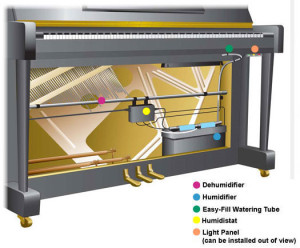
Here is what the system looks like in a Grand Piano:
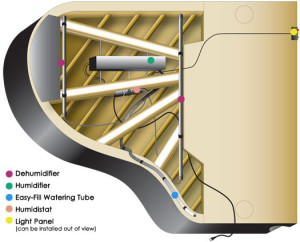
I strongly advocate the use of the Dampp Chaser Humidty control system. It will allow you to maintain optimal conditions inside your instrument, get a lot more pleasure out of using it, and spend a lot less money fixing it.
To have one of these systems installed, please visit http://lapianotuning.com to set up an appointment.
